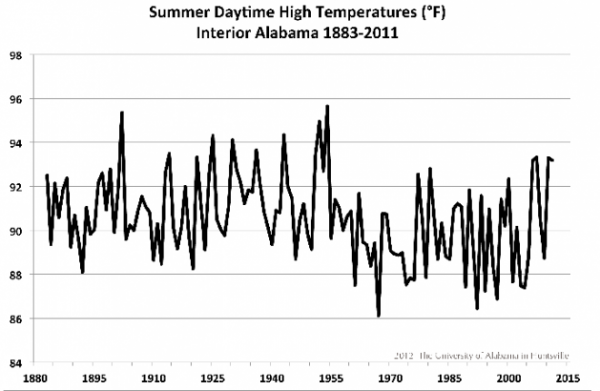The Heat, And Alabama Climatology
A release from UAH this afternoon. A very, very good read.
Do recent hot summers (and 100 degrees today) signal a return to high temperatures seen in Alabama’s past?
HUNTSVILLE, Ala. (June 29, 2012) — Four hot summers in the past six years and June temperatures topping the 100 degree mark across the state have Alabama’s state climatologist wondering if the state might be returning to the hotter summer climate that once was normal for this part of the country. “You have to wonder if we are returning to the climate of our grandparents,” said Dr. John Christy, Alabama’s climatologist and a professor of atmospheric science at The University of Alabama in Huntsville, “although they would have suffered more because air conditioning wasn’t nearly as common back then.”
Average summer high temperatures across Alabama have been lower than historic norms since the record hot summer of 1954.
“Temperatures fell off of a cliff after 1954,” Christy said. Between 1883 and 1954, Alabama’s average summer high temperature was 91.2. From 1955 through 2011 it dropped to 89.8.
“In fact, from 1883 though 1964, every summer saw at least one station in Alabama hit 100 Fahrenheit or higher,” Christy said. “Since 1964 there have been five years — 1965, 1974, 1994, 2001 and 2003 — when no station in the state hit 100. And there are more weather stations now than there were when the record started.
“The two coolest summers were 1967, with a statewide average high that was only 86.11 degrees, and 1992.” Using data from 75 weather stations from Greenville to Tennessee, Christy developed a set of temperature records going back to 1883. Looking only at average high temperatures for June, July and August, he found that the average for the past six summers was the hottest since 1952-1957.
While 2006-2011 was the hottest six-summer stretch in more than half a century, it was only the tenth hottest six-summer period on the 129-year record. That seems to eliminate manmade global warming as a likely cause for the recent hot summers, Christy said. “Since these temperatures aren’t higher than earlier temperatures, it doesn’t look like ‘global warming,’ but more like a problem we still wrestle with: unpredictable natural variability,” Christy said. “No one really knows
what triggers these natural shifts in the climate.”
Despite the recent warm summers, Alabama’s long-term summer temperature trend over the entire 129-year period is cooling at the rate of about 0.12 degree Fahrenheit per decade. That means summer high temperatures for the several summers before 2006 were about 1.5 degrees F cooler than they were in the late 1800s and early 1900s. That won’t make it any cooler outside this weekend.
The hottest summers in the 129-year record were 1954, with an average summer high of 95.6 degrees, and 1902 at 95.36.
Alabama’s 20 Hottest Summers
1954 95.65
1902 95.36
1952 94.95
1943 94.35
1925 94.32
1930 94.13
1936 93.66
1914 93.49
1951 93.43
1921 93.34
2007 93.34
2010 93.30
2011 93.19
2006 93.17
1980 92.80
1899 92.79
1931 92.78
1953 92.70
1913 92.65
1897 92.61
For more information:
Dr. John Christy, (256) 961-7763
john.christy@nsstc.uah.edu
Phillip Gentry, (256) 961-7618
gentry@nsstc.uah.edu
Category: Met 101/Weather History
















